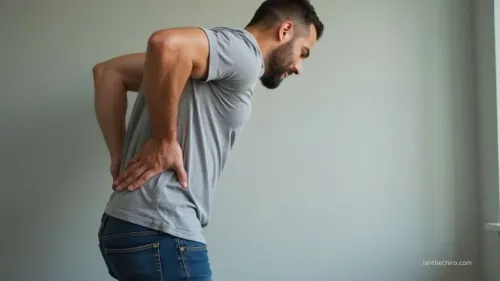Can Chiropractic Care Help De Quervain Tenosynovitis? Surprising Connections to Neck
If you're struggling with De Quervain's Tenosynovitis, consider exploring chiropractic care for relief.
The comprehensive approach connects neck alignment with wrist pain, offering treatments like spinal adjustments and myofascial release to improve joint mobility and reduce inflammation. Customised ergonomic assessments and exercises further support your healing journey. Chiropractic care focuses on whole-body balance, which means addressing neck issues might relieve wrist discomfort too.
Check out how this tailored approach could transform your well-being.
What Is De Quervain’s Tenosynovitis and Why It Happens

De Quervain's tenosynovitis is a condition that involves inflammation of the tendons on the thumb side of your wrist, particularly affecting the abductor pollicis longus and extensor pollicis brevis.
You're likely to feel significant pain and difficulty with thumb and wrist movements, especially during repetitive activities like lifting or gardening.
This condition often affects women between 30 and 50, sometimes during pregnancy or while caring for infants.
Symptoms include thumb base pain, swelling, and a catching sensation.
Chronic wrist overuse and repetitive movements typically cause this inflammation, restricting tendon movement and demanding a thorough, patient-centered approach for relief.
How Neck Issues Can Affect Wrist and Thumb Pain
When neck issues arise, they can unexpectedly contribute to wrist and thumb pain, complicating conditions like De Quervain Tenosynovitis.
Neck tension and misalignment can alter your posture, placing extra stress on your wrist and thumb. The cervical spine's alignment affects nerve function and blood flow, impacting your arm's muscles and tendons, potentially worsening wrist pain.
Trigger points in neck muscles may refer pain to your shoulder and upper extremities, influencing thumb and wrist mechanics.
Studies show that neck pain can lead to compensatory behaviors, straining your wrist and thumb, heightening the risk of developing or worsening this condition.
How Chiropractic Care Addresses Full-Body Imbalances

Understanding the intricate relationship between neck issues and wrist pain is just the beginning of addressing De Quervain's tenosynovitis.
Chiropractic care targets full-body imbalances by realigning the spine and joints, which can profoundly influence your musculoskeletal health. Adjustments promote better joint mobility, potentially reducing compensatory movement patterns that worsen wrist pain.
Chiropractors may assess your ergonomics, guiding you to modify activities that strain your wrist and affect neck alignment. Soft tissue therapies can ease neck and shoulder tension linked to wrist dysfunction.
This holistic approach recognises how imbalances in one area affect others, fostering thorough healing and recovery.
Chiropractic Techniques for De Quervain’s Tenosynovitis
A variety of chiropractic techniques can effectively address De Quervain’s Tenosynovitis, focusing on restoring function and alleviating pain in the wrist and thumb.
You might find wrist joint mobilisation techniques enhance mobility and reduce discomfort. Soft tissue therapies, like myofascial release, work wonders in easing inflammation and muscle tension.
Chiropractors often suggest ergonomic adjustments and activity modifications to prevent further strain. They’ll guide you through strengthening and stretching exercises for the wrist, thumb, and forearm to boost recovery.
A thorough assessment of your lifestyle habits will help pinpoint contributing factors, promoting healthier biomechanics in your hand and wrist movements.
Benefits of Chiropractic Treatment for Wrist Pain and Recovery
If you're suffering from wrist pain, chiropractic treatment can be a game-changer in your recovery journey.
By focusing on wrist joint mobilisation, chiropractors enhance mobility and alleviate pain. Soft tissue therapies target muscle tension and inflammation, promoting faster healing.
Chiropractors enhance wrist mobility and alleviate pain through joint mobilisation and soft tissue therapies.
Ergonomic assessments help identify activities that worsen symptoms, allowing you to prevent future flare-ups. Chiropractors also prescribe strengthening and stretching exercises to restore function and improve biomechanics.
Research shows that addressing wrist issues can positively impact associated conditions like neck pain, as it encourages better posture and movement patterns.
Chiropractic care offers a thorough, evidence-based approach to wrist recovery.
Frequently Asked Questions About De Quervain’s Tenosynovitis and Chiropractic Care
Can a Chiropractor Help With Tenosynovitis?
Yes, chiropractic care can support recovery from tenosynovitis. Chiropractors address musculoskeletal imbalances, reduce local inflammation, and improve joint function. Treatment is typically tailored to your condition and may include manual therapy, soft tissue work, and lifestyle advice to prevent recurrence.
Can a Chiropractor Help With Neck Issues?
Chiropractors commonly treat neck pain. Techniques such as spinal adjustments and soft tissue therapy help reduce discomfort, restore range of motion, and support long-term spinal health. Treatment plans are customised to your needs and goals.
Which Nerve Is Affected in De Quervain's Tenosynovitis?
De Quervain’s tenosynovitis can involve irritation around the superficial branch of the radial nerve, contributing to pain near the thumb. Chiropractors may focus on reducing surrounding tension and improving movement in the wrist and forearm to alleviate symptoms.
Which Specialist Treats De Quervain Tenosynovitis?
De Quervain's is often treated by orthopedists, hand specialists, or rheumatologists. Chiropractors may also help manage symptoms through non-invasive care, addressing biomechanics, muscle tension, and nerve-related discomfort for improved function and recovery.
Why Chiropractic May Be a Worthwhile Option for De Quervain’s Relief
In managing De Quervain’s tenosynovitis, chiropractic care offers a practical, non-invasive approach focused on addressing the underlying causes of discomfort. By improving joint alignment, reducing muscle tension, and restoring balance in the musculoskeletal system, chiropractic care supports long-term recovery.
This approach emphasises not just symptom relief, but lasting improvements in mobility and function, helping you return to daily activities with greater ease and less pain.














